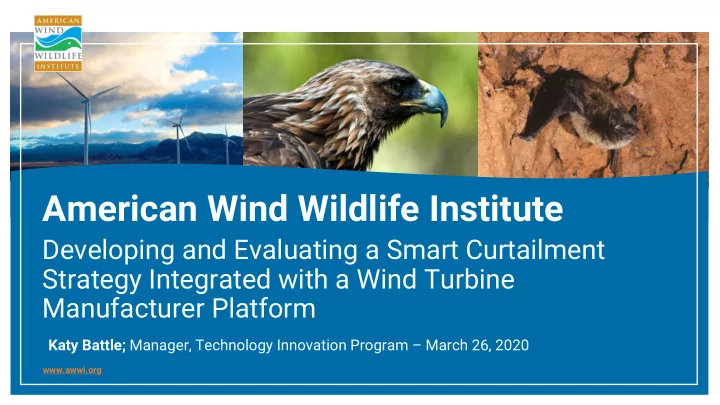

American Wind Wildlife Institute Developing and Evaluating a Smart Curtailment Strategy Integrated with a Wind Turbine Manufacturer Platform Katy Battle; Manager, Technology Innovation Program – March 26, 2020 www.awwi.org
Overview of the VBPS Technology • Problem o Blanket curtailment is a coarse and bio/ecologically uninformed strategy • Vestas Bat Protection System (VBPS) Technology o Newly developed software module in Vestas turbines’ Supervisory Control And Data Acquisition (SCADA) systems o Environmental data → Algorithm → Bat fatality risk estimate → SCADA → Smart curtailment orders • Solution o Improved efficiency (less power production loss) and improved efficacy (reduced bat fatalities) better than Blanket curtailment 2
Project Goal and Objectives • Project Goals: • Develop a VBPS smart curtailment strategy that minimizes bat fatalities more efficiently than does than blanket curtailment by minimizing power production loss • Project Objectives: • Develop and evaluate a model-based smart curtailment strategy using VBPS based on bat activity, bat fatalities, and environmental variables • Evaluate the economic, power production, and other Annual Energy Production (AEP) implications of this VBPS smart curtailment strategy 3
Project Team and Roles • American Wind Wildlife Institute (AWWI) • Prime Award Recipient • Project Managers (Stu Webster and Katy Battle) • Principle Investigator (Taber Allison) • Bat Conservation International (BCI) • Award Subrecipient • Field Study Principle Investigators (Winfred Frick, Michael Schirmacher, and Mike Whitby) • MidAmerican Energy Company (MEC) Host Site, Operations, and SCADA support (Jesse Leckband) • • Vestas Americas (VA) • Technology Vendor (Tom Allain) • Washington State University (WSU) • Project Statistician and model developer (Leslie New) 4
General Study Plan: Experimental Approach • Study Site: o MEC’s Orient windfarm in Adair County, Iowa • 3 Phases: o Phase 1: Environmental and biological data collection o Phase 2: Algorithm development for smart curtailment strategy o Phase 3: Experimental testing of selected curtailment strategies 5
General Study Plan: Experimental Approach • Phase 1: Environmental and Biological Data Collection o 10 turbines operating under normal operator parameters o Biweekly SCADA data requests o Weather data (3 spatial and 3 temporal scales) o Bat Data ▪ Acoustic Surveys ▪ Thermal Videography ▪ Carcass Searches 6
General Study Plan: Experimental Approach • Phase 2: Algorithm Development for Smart Curtailment Strategy o Determine correlates between carcass/acoustic and between carcass/thermal data o Model bat fatality risk according to weather data and develop curtailment strategies. Inform algorithm with best-performing model o Estimate theoretical risk reduction and power loss resulting from curtailment strategies and compare against blanket curtailment 7
General Study Plan: Experimental Approach • Phase 3: Experimental Testing of Various Curtailment Strategies o 18 turbines operating assigned strategy via Randomized Block Design (RBD) ▪ 6 control, 6 blanket curtailment, 6 VBPS-programed smart curtailment strategies o Biweekly SCADA data requests o Fatality, acoustic, and thermal camera monitoring o Comparative analysis of blanket and smart curtailment strategies o AEP and strategy cost-to-implement comparative analysis 8
Expected Outcomes • Project Start: 09/01/2019 (awarded) o BP1: 09/01/2019 – 4/30/2021 ▪ Year 1 field study: June - October 2020 ▪ Bat fatality risk model development: Spring 2021 o BP2: 05/01/2021 – 8/31/2022 ▪ Power production stats: Spring 2021 ▪ Year 2 field study: June - October 2021 ▪ Final report to DOE: Summer 2022 ▪ Manuscript to journal: Summer 2022 • Project End: 8/31/2022 9
DOE Acknowledgment This material is based upon work supported by the U.S. Department of Energy’s Office of Energy Efficiency and Renewable Energy (EERE) under the Wind Energy Technology Office Award Number DE-EE0008729 For further information, DOE- EERE’s program, please visit their webpage at: https://www.energy.gov/eere/wind/environmental-impacts-and-siting-wind-projects 10
Thank You! Questions? Stu Webster Sr. Manager; Technology, Innovation, and Research swebster@awwi.org 503-320-1099 Katy Battle Manager; Technology, Innovation, and Research kbattle@awwi.org 202-448-8774 www.awwi.org 11
Acronyms Used • AEP: Annual Energy Production • AWWI: American Wind Wildlife Institute • BCI: Bat Conservation International • BP: Budget Period • DOE: Department of Energy • MEC: MidAmerican Energy Company • SCADA: Supervisory Control and Data Acquisition • VA: Vestas Americas • VBPS: Vestas Bat Protection System • WSU: Washington State University 12
Recommend
More recommend